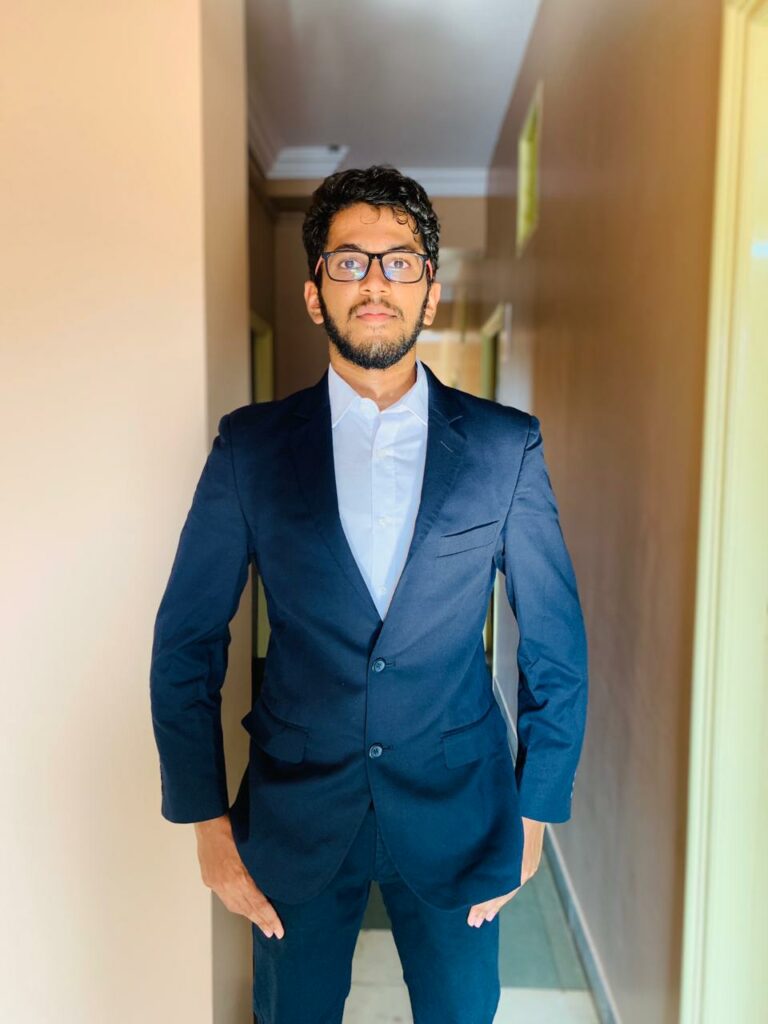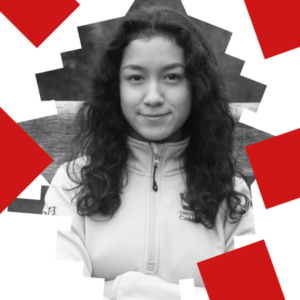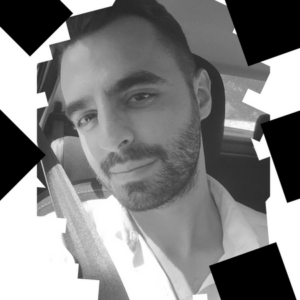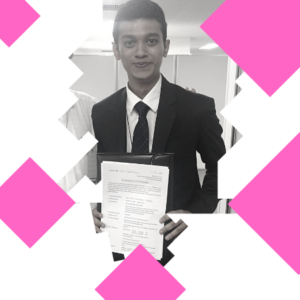
Home » Success Story- 25355
COMPANY:
Japanese multinational electronics and electrical equipment manufacturing company
A graduate of Bisbubaraya Institute of Technology, India. Department of Aerospace Engineering. In the internship of Tata Sikorsky Aerospace (TSAL), he was assigned to the manufacturing engineering department of airplane parts and engines and performed a quality inspection of parts and recording of the manufacturing process. His graduation research was “Design, Manufacturing, and Testing of Wind Turbines for Electric Vehicle Charging Centers”, aiming to supply a charging infrastructure that cannot keep up with the spread of electric vehicles. Experienced a series of processes from design to testing. He sympathizes with the Japanese working culture that values teamwork and hopes to find a job in Japan.
What the company thought:High level of Japanese language ability and willingness to continue to improve it. Uniqueness of the purpose and focus of the research, and the experience of actually creating, operating, verifying, and improving things in a series of processes.
Profile
COUNTRY / REGION
India
SEX
Male
UNIVERSITY
Visvesvaraya Technological University
SPECIALIZATION
Aerospace
ACADEMIC LEVEL
Bachelor
MESSAGE
I’ve been watching anime since I was little, so I liked Japan. When I became a high school student, I was able to access the Internet, and when I saw the lives of foreigners living and working in Japan and Japanese people, I thought it was really amazing. Of course, I wanted to go to Japan and work in Japan, but I thought it was impossible. When I was in the 4th grade at MITE University, I was aiming to study for a master’s degree in Canada, and I paid a lot of money for it, took an English test, and secured the required points. After a while, I was offered the opportunity to study Japanese at university. I thought that was my destiny, so I chose Japanese language training without hesitation. First, I learned Japanese from Japanese teacher Ihara Takamichi. The teacher told me that I had the potential to achieve N1. Encouraged by those words, I decided to study N2 myself after passing N3.
In October 2021, my friend introduced me to the services of FAST OFFER International Program (formerly Study Go Work JAPAN Program). My Japanese ability was tested in the first interview. In addition, they explained the information required for the interview in an easy-to-understand manner. I wasn’t confident in my Japanese, but I was relieved that the FAST OFFER Int’l staff told me that it was good and I could have an interview without any problem. I was matched with a certain company in November 2021. A mentoring session was held before each stage of the interview. There, we discussed the expected contents of the questions at each stage; how to answer them, what should not be done, and what should be said to make a good impression. Not only that, but you can also decide the time of your mentoring session to suit your schedule. Without those mentoring sessions, I couldn’t have been able to interview. The scariest thing for me was to fully explain my research theme with PPT. But after discussing with the FAST OFFER Int’l mentor, the project description reached 15 minutes instead of 10 minutes. Before taking the SPI test, I emailed my mentor when I was worried about the content of the test. He answered my question promptly. Not only that, but Kojima san of FAST OFFER Int’l also wrote a separate email to answer my questions. I was really impressed.
I am looking forward to going to Japan and starting my career.
In October 2021, my friend introduced me to the services of FAST OFFER International Program (formerly Study Go Work JAPAN Program). My Japanese ability was tested in the first interview. In addition, they explained the information required for the interview in an easy-to-understand manner. I wasn’t confident in my Japanese, but I was relieved that the FAST OFFER Int’l staff told me that it was good and I could have an interview without any problem. I was matched with a certain company in November 2021. A mentoring session was held before each stage of the interview. There, we discussed the expected contents of the questions at each stage; how to answer them, what should not be done, and what should be said to make a good impression. Not only that, but you can also decide the time of your mentoring session to suit your schedule. Without those mentoring sessions, I couldn’t have been able to interview. The scariest thing for me was to fully explain my research theme with PPT. But after discussing with the FAST OFFER Int’l mentor, the project description reached 15 minutes instead of 10 minutes. Before taking the SPI test, I emailed my mentor when I was worried about the content of the test. He answered my question promptly. Not only that, but Kojima san of FAST OFFER Int’l also wrote a separate email to answer my questions. I was really impressed.
I am looking forward to going to Japan and starting my career.

FINAL YEAR PROJECT
1.題名:電気自動車充電センター向け電力供給用風力タービンの設計、製造とテスティング
2.研究の目的
インドでは最近、電子自動車の数は増加する一方です。
今の充電インフラで将来の需要を満たすことはできません。さらに充電センターに供給されている電気は石炭で生成されています。石炭の使用では環境に地球温暖化などの色々な問題があります。
この問題を解決するために電気自動車を石炭を使って生成された電気で充電するのでは温暖化に効果がありません。
風力タービンを使えば環境に影響を与えないで充電できます。それでこのプロジェクトをすることにしました。
風力タービンを使って電気自動車充電センターに電気を供給できるかを見つけ出すのが主な目的です。
3.実施内容
①システムの仕組み
このプロジェクトで作られた風力タービンを高速道路の仕切りに設置されます。
道路を走る車によって風が吹きその風に含まれるエネルギーによって風力タービンのブレードが回って、それに取り付けられている発電機が電気を生成します。この電気は 電子自動車充電ステーションに供給できます。
このプロジェクトを様々な段階に分けました。
②最初に風力タービンのに関する色々な研究論文を集めました。
風力タービンの中でも種類がたくさんあります。大きく分けると縦アクシス風力タービンと横アクシス風力タービンがあります。縦アクシス風力は大きくて風の方向に向けていないと回転できません。
一方、横アクシス風力タービンは風の方向に関わらずに回転できます。道路の両側に風が吹くのでこれはもっと適当です。集めた研究論文でこの使用に合う最適タイプを選びました。
③次は “Q-ブレード”というソフトを使って、理論的な分析をしました。
その分析で風力タービンの発電に影響を与える様々な要因と要素を考慮して、発電とそれぞれの要因との数学的な関係を見つけそれを操ってソフトで設計しました。何度も試行錯誤して理想の結果を得ました。
④充電センターに電気を供給出来るように大量で道路の仕切りに風力タービンを設置するが必要があります。
それらの風力タービンの間の距離も大切な要因です。それも同じソフトで分析し最適な距離を算出しました。
次は実際にプロトタイプを作って実験を行いました。
4.結果
風力タービンが設計した通り機能しているかないかそれを確認するために、大学の空気力学の研究室にある大きい扇風機で実験を行いました。
この扇風機が高速道路でのような風を再現することができます。さらに出る風の速度も正確に制御することができます。その特徴を使って、毎秒5メートルから毎秒15メートルの風の速度に相当する発電のデータを取得しました。それ共に、正常回転の範囲と上達できるところなどを見つけました。
平均速度は毎秒9メートルで、それに相当する発電は22ワットで風力タービンの間の距離は7メートルでした。
5.振り返り
①作製した風力タービンは設計した通り機能していました。しかし発電量は思ったより低かった。
理由は2つあります。1つ目はブレードと風力タービンのシャフトを接続するために使ったベアリングの質が良くなかったからです。そのため、摩擦が生じて、それは回転の抵抗となっていました。
良い質のベアリングを使えばこの問題を解決できます。2つ目はここで使った発電機はこの風力タービンに合っていなかったと思います。そのため少しエネルギーが失われていました。大量で製造する時は風力タービンに合っている発電機を別に作ればこの問題を解決できます。
②最後に私が気づいたのは理論的な分析に時間を費やすよりある程度まで基礎的な計算して、直接プロトタイプを作れば、もっと効果的だと思います。
実際の実験から得たデータは理論的な分析のデータより役に立ちます、さらにどこに問題があるのかを開発の最初の段階で見つけることができます。もちろん最初には障害が多くあるが全体的にはより効果的な方法だと思います
③エンジニアは問題を解決できるような能力があるのは必要です。同時に問題を予測して、それを問題にならないようにするの方が大事だと思います。
追加情報
1. 実験で取得したデータで研究論文を作って、アメリカの科学の組織に出版しました。
https://aip.scitation.org/doi/abs/10.1063/5.0033976 このリンクでその研究論文をダウンロードすることができます
2. プロジェクトは 州レベルの政府の競争に優勝して、航空工学の中で “年の最高なプロジェクト”と言うタイトルをもらいました。
2.研究の目的
インドでは最近、電子自動車の数は増加する一方です。
今の充電インフラで将来の需要を満たすことはできません。さらに充電センターに供給されている電気は石炭で生成されています。石炭の使用では環境に地球温暖化などの色々な問題があります。
この問題を解決するために電気自動車を石炭を使って生成された電気で充電するのでは温暖化に効果がありません。
風力タービンを使えば環境に影響を与えないで充電できます。それでこのプロジェクトをすることにしました。
風力タービンを使って電気自動車充電センターに電気を供給できるかを見つけ出すのが主な目的です。
3.実施内容
①システムの仕組み
このプロジェクトで作られた風力タービンを高速道路の仕切りに設置されます。
道路を走る車によって風が吹きその風に含まれるエネルギーによって風力タービンのブレードが回って、それに取り付けられている発電機が電気を生成します。この電気は 電子自動車充電ステーションに供給できます。
このプロジェクトを様々な段階に分けました。
②最初に風力タービンのに関する色々な研究論文を集めました。
風力タービンの中でも種類がたくさんあります。大きく分けると縦アクシス風力タービンと横アクシス風力タービンがあります。縦アクシス風力は大きくて風の方向に向けていないと回転できません。
一方、横アクシス風力タービンは風の方向に関わらずに回転できます。道路の両側に風が吹くのでこれはもっと適当です。集めた研究論文でこの使用に合う最適タイプを選びました。
③次は “Q-ブレード”というソフトを使って、理論的な分析をしました。
その分析で風力タービンの発電に影響を与える様々な要因と要素を考慮して、発電とそれぞれの要因との数学的な関係を見つけそれを操ってソフトで設計しました。何度も試行錯誤して理想の結果を得ました。
④充電センターに電気を供給出来るように大量で道路の仕切りに風力タービンを設置するが必要があります。
それらの風力タービンの間の距離も大切な要因です。それも同じソフトで分析し最適な距離を算出しました。
次は実際にプロトタイプを作って実験を行いました。
4.結果
風力タービンが設計した通り機能しているかないかそれを確認するために、大学の空気力学の研究室にある大きい扇風機で実験を行いました。
この扇風機が高速道路でのような風を再現することができます。さらに出る風の速度も正確に制御することができます。その特徴を使って、毎秒5メートルから毎秒15メートルの風の速度に相当する発電のデータを取得しました。それ共に、正常回転の範囲と上達できるところなどを見つけました。
平均速度は毎秒9メートルで、それに相当する発電は22ワットで風力タービンの間の距離は7メートルでした。
5.振り返り
①作製した風力タービンは設計した通り機能していました。しかし発電量は思ったより低かった。
理由は2つあります。1つ目はブレードと風力タービンのシャフトを接続するために使ったベアリングの質が良くなかったからです。そのため、摩擦が生じて、それは回転の抵抗となっていました。
良い質のベアリングを使えばこの問題を解決できます。2つ目はここで使った発電機はこの風力タービンに合っていなかったと思います。そのため少しエネルギーが失われていました。大量で製造する時は風力タービンに合っている発電機を別に作ればこの問題を解決できます。
②最後に私が気づいたのは理論的な分析に時間を費やすよりある程度まで基礎的な計算して、直接プロトタイプを作れば、もっと効果的だと思います。
実際の実験から得たデータは理論的な分析のデータより役に立ちます、さらにどこに問題があるのかを開発の最初の段階で見つけることができます。もちろん最初には障害が多くあるが全体的にはより効果的な方法だと思います
③エンジニアは問題を解決できるような能力があるのは必要です。同時に問題を予測して、それを問題にならないようにするの方が大事だと思います。
追加情報
1. 実験で取得したデータで研究論文を作って、アメリカの科学の組織に出版しました。
https://aip.scitation.org/doi/abs/10.1063/5.0033976 このリンクでその研究論文をダウンロードすることができます
2. プロジェクトは 州レベルの政府の競争に優勝して、航空工学の中で “年の最高なプロジェクト”と言うタイトルをもらいました。




